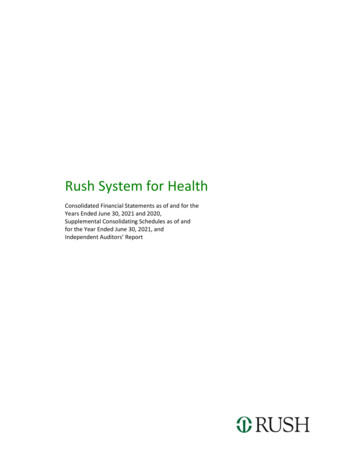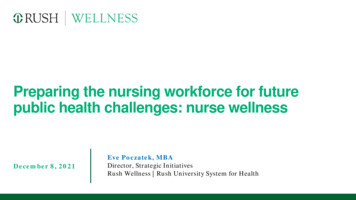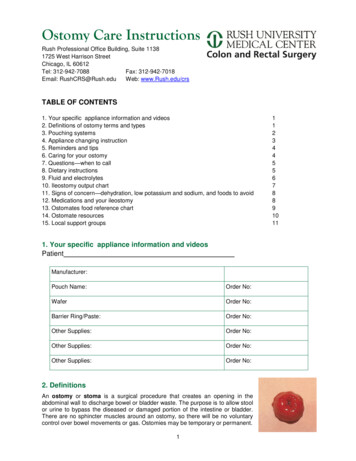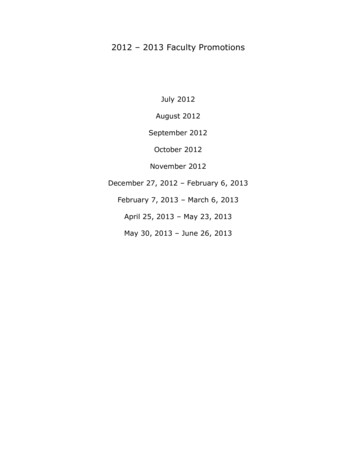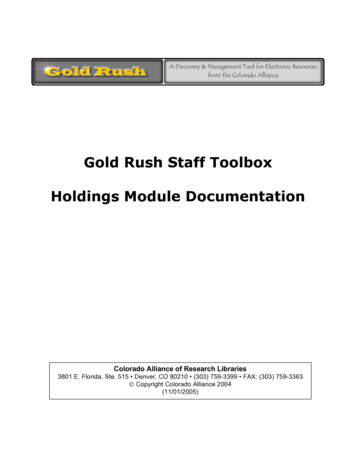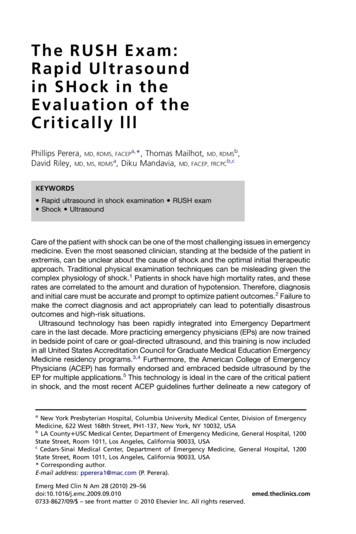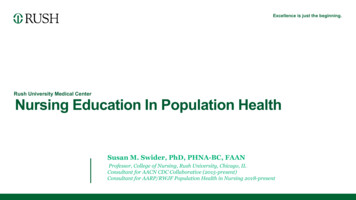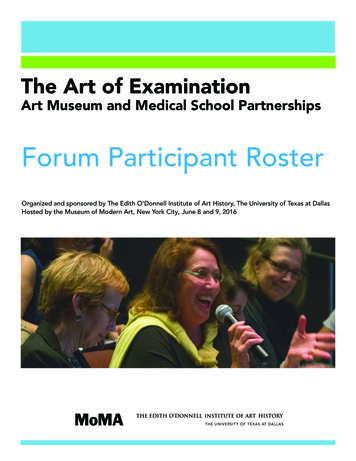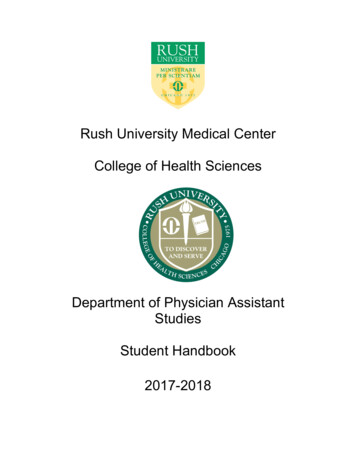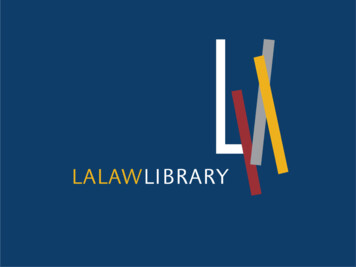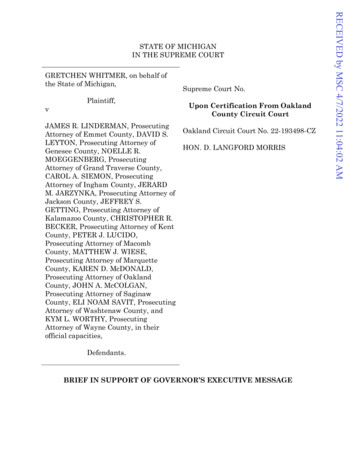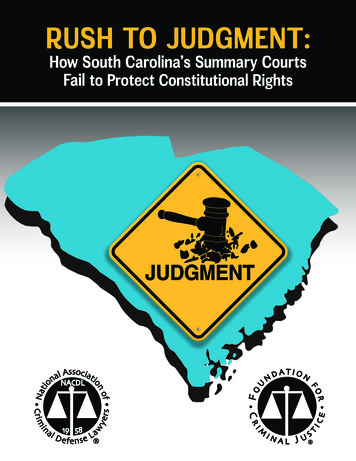
Transcription
RUSH TO JUDGMENT:How South Carolina’s Summary CourtsFail to Protect Constitutional RightsJUDGMENT
Copyright 2017 National Association of Criminal Defense LawyersREPORTSOUTHCAROLINAThis work is licensed under the Creative Commons Attribution-NonCommercialNoDerivatives 4.0 International License. To view a copy of this license, 4.0/. It may be reproduced, provided that nocharge is imposed, and the National Association of Criminal Defense Lawyers is acknowledgedas the original publisher and the copyright holder. For any other form of reproduction, pleasecontact NACDL for permission.For more information contact:National Association of Criminal Defense Lawyers 1660 L Street NW, 12th Floor, Washington, DC 20036Phone 202-872-8600WWW.NACDL.ORGThis publication is available online atwww.nacdl.org/summaryinjustice
RUSH TO JUDGMENT:How South Carolina’s Summary CourtsFail to Protect Constitutional RightsAuthorsAlisa Smith, J.D., Ph.D.Associate Professor and Chair, Legal Studies Dept.University of Central FloridaAssociate Professor, Criminology and Criminal JusticeUniversity of TampaDiane DePietropaolo PricePublic Defense Training ManagerNational Association of Criminal Defense LawyersColette TvedtPublic Defense Training and Reform DirectorNational Association of Criminal Defense LawyersREPORTSean Maddan, Ph.D.SOUTHCAROLINA
Table of Contents2REPORTSOUTHCAROLINAAbout the National Association of Criminal Defense Lawyers . . . . . . . . . . . . . . . 3Acknowledgements . . . . . . . . . . . . . . . . . . . . . . . . . . . . . . . . . . . . . . . . . . . . . . . . . . . . . . . . . . . 4Foreword . . . . . . . . . . . . . . . . . . . . . . . . . . . . . . . . . . . . . . . . . . . . . . . . . . . . . . . . . . . . . . . . . . . . . . 5Executive Summary . . . . . . . . . . . . . . . . . . . . . . . . . . . . . . . . . . . . . . . . . . . . . . . . . . . . . . . . . . . 6Introduction . . . . . . . . . . . . . . . . . . . . . . . . . . . . . . . . . . . . . . . . . . . . . . . . . . . . . . . . . . . . . . . . . . . 8Methodology . . . . . . . . . . . . . . . . . . . . . . . . . . . . . . . . . . . . . . . . . . . . . . . . . . . . . . . . . . . . . . . . 12Docket Availability . . . . . . . . . . . . . . . . . . . . . . . . . . . . . . . . . . . . . . . . . . . . . . . . . . . . . . . . . . . . . 12Demographics . . . . . . . . . . . . . . . . . . . . . . . . . . . . . . . . . . . . . . . . . . . . . . . . . . . . . . . . . . . . . . . . 14Findings . . . . . . . . . . . . . . . . . . . . . . . . . . . . . . . . . . . . . . . . . . . . . . . . . . . . . . . . . . . . . . . . . . . . . . 16Quick, Police-Dominated Justice . . . . . . . . . . . . . . . . . . . . . . . . . . . . . . . . . . . . . . . . . . . . . . . 16Justice Delayed . . . . . . . . . . . . . . . . . . . . . . . . . . . . . . . . . . . . . . . . . . . . . . . . . . . . . . . . . 18Negotiating Charges with the Police . . . . . . . . . . . . . . . . . . . . . . . . . . . . . . . . . . . . 19Two-Minute Justice . . . . . . . . . . . . . . . . . . . . . . . . . . . . . . . . . . . . . . . . . . . . . . . . . . . . . 19Gender/Race and (In)justice . . . . . . . . . . . . . . . . . . . . . . . . . . . . . . . . . . . . . . . . . . . . . . . . . . . 21Counties . . . . . . . . . . . . . . . . . . . . . . . . . . . . . . . . . . . . . . . . . . . . . . . . . . . . . . . . . . . . . . . . 22Courts . . . . . . . . . . . . . . . . . . . . . . . . . . . . . . . . . . . . . . . . . . . . . . . . . . . . . . . . . . . . . . . . . . 23Advisement of Rights . . . . . . . . . . . . . . . . . . . . . . . . . . . . . . . . . . . . . . . . . . . . . . . . . . . . . . . . . . 25Group Advisement . . . . . . . . . . . . . . . . . . . . . . . . . . . . . . . . . . . . . . . . . . . . . . . . . . . . . . 25The Rights Included in the Opening Advisement . . . . . . . . . . . . . . . . . 27Inconsistency across Counties in the Specific RightsIncluded in the Opening of Court Sessions . . . . . . . . . . . . . . . . . . . . . . . 28Individual Advisement by Interacting with the Trial Judge . . . . . . . . . . . . . . . 31Outcomes . . . . . . . . . . . . . . . . . . . . . . . . . . . . . . . . . . . . . . . . . . . . . . . . . . . . . . . . . . . . . . . . . . . . 33Pretrial Intervention . . . . . . . . . . . . . . . . . . . . . . . . . . . . . . . . . . . . . . . . . . . . . . . . . . . . . . . . . . . 33Waivers of Rights . . . . . . . . . . . . . . . . . . . . . . . . . . . . . . . . . . . . . . . . . . . . . . . . . . . . . . . . . . . . . . 33Guilty/No Contest Pleas . . . . . . . . . . . . . . . . . . . . . . . . . . . . . . . . . . . . . . . . . . . . . . . . . . . . . . . 35Bench Trials . . . . . . . . . . . . . . . . . . . . . . . . . . . . . . . . . . . . . . . . . . . . . . . . . . . . . . . . . . . . . . . . . . . 35Sanctions . . . . . . . . . . . . . . . . . . . . . . . . . . . . . . . . . . . . . . . . . . . . . . . . . . . . . . . . . . . . . . . . . . . . . 37Fines . . . . . . . . . . . . . . . . . . . . . . . . . . . . . . . . . . . . . . . . . . . . . . . . . . . . . . . . . . . . . . . . . . . . . . . . . . 37Jail . . . . . . . . . . . . . . . . . . . . . . . . . . . . . . . . . . . . . . . . . . . . . . . . . . . . . . . . . . . . . . . . . . . . . . . . . . . . 39Post-Sanction Rights and Consequences Advisements . . . . . . . . . . . . . . . . . . . . . . . . . 40Recommendations . . . . . . . . . . . . . . . . . . . . . . . . . . . . . . . . . . . . . . . . . . . . . . . . . . . . . . . . . . . 42Endnotes . . . . . . . . . . . . . . . . . . . . . . . . . . . . . . . . . . . . . . . . . . . . . . . . . . . . . . . . . . . . . . . . . . . . . 44
About the National Association ofCriminal Defense LawyersThe National Association of Criminal Defense Lawyers (NACDL) is the preeminent organization in theUnited States advancing the goal of the criminal defense bar to ensure justice and due process forpersons charged with a crime or wrongdoing. NACDL’s core mission is to: Ensure justice and due processfor persons accused of crime Foster the integrity, independence and expertise of the criminal defenseprofession Promote the proper and fair administration of criminal justice.The Foundation for Criminal Justice (FCJ) is a 501(c)(3) charitable non-profit organized to preserve andpromote the core values of America’s criminal justice system guaranteed by the Constitution — amongthem access to effective counsel, due process, freedom from unreasonable search and seizure, and fairsentencing. The FCJ supports NACDL’s charitable efforts to improve America’s public defense system,and other efforts to preserve core criminal justice values through resources, education, training, andadvocacy tools for the public and the nation’s criminal defense bar.REPORTFounded in 1958, NACDL has a rich history of promoting education and reform through steadfastsupport of America’s criminal defense bar, amicus curiae advocacy and myriad projects designed tosafeguard due process rights and promote a rational and humane criminal justice system. NACDL’sapproximately 9,200 direct members — and 90 state, local and international affiliate organizationstotalling up to 40,000 members — include private criminal defense lawyers, public defenders, activeU.S. military defense counsel, and law professors committed to preserving fairness in America’s criminaljustice system. Representing thousands of criminal defense attorneys who know firsthand theinadequacies of the current system, NACDL is recognized domestically and internationally for itsexpertise on criminal justice policies and best practices.SOUTHCAROLINAFor more information contact:NATIONAL ASSOCIATION OFCRIMINAL DEFENSE LAWYERS 1660 L Street NW, 12th FloorWashington, DC 20036202-872-8600www.nacdl.orgThis publication is available online atwww.nacdl.org/summaryinjusticeRUSH TO JUDGMENT: How South Carolina’s Summary Courts Fail to Protect Consitutional Rights3
AcknowledgementsThe authors wish to thank the Board of Directors of the National Association of Criminal Defense Lawyers(NACDL) and the Board of Trustees for the Foundation for Criminal Justice (FCJ) for their support of thisproject. We also thank Koch Industries for their support. Our gratitude is also extended to the AmericanCivil Liberties Union (ACLU) and the ACLU of South Carolina for their assistance in recruiting and workingwith volunteer data collectors for this project and providing feedback on the survey tool.This report was prepared by Alisa Smith, JD, Ph.D., of the University of Central Florida; Sean Maddan, Ph.D.,of the University of Tampa; Diane DePietropaolo Price, JD, of NACDL; and Colette Tvedt, JD, of NACDL. Dr.Smith served as the lead researcher on this report, and Dr. Maddan served as the primary statistician. DianeDePietropaolo Price and Colette Tvedt served as co-authors. Dr. Smith is the chair of the Legal StudiesDepartment at the University of Central Florida and Dr. Maddan is a professor of criminology and criminaljustice at the University of Tampa; both seek to improve our criminal justice systems through thedevelopment and dissemination of criminal justice research. Diane DePietropaolo Price is the Public DefenseTraining Manager for NACDL, and Colette Tvedt is the Director of Public Defense Training and Reform forNACDL; both work to improve the quality of public defense services nationwide through a combination oftraining, advocacy, and reform efforts.REPORTSOUTHCAROLINAThe authors express their thanks to all those who assisted in the research and data collection for this report.Individuals from the ACLU, University of South Carolina Law School (USC), Charleston School of Law (CSOL),University of Tampa (UT), and Yale Law School (Yale) all participated in data gathering. Emma Andersson,staff attorney for the ACLU Criminal Law Reform Project, provided valuable feedback on the survey tool andrecruited volunteers from Yale Law School to participate in the project. Nathan Rouse, fellow with the ACLUCriminal Law Reform Project, coordinated the work of the Yale Law students and also participated in datagathering. Susan Dunn of the South Carolina ACLU connected the researchers with local faculty to identifystudent volunteers and provided helpful background information. Neena Speer, National Affairs Intern forNACDL, called dozens of courts to learn about court schedules and docket availability. Pam Robinson, SethStoughton, Susan Kwo, and Michelle Condon were instrumental in helping to recruit student volunteersfrom the South Carolina schools. Thanks to all those who gathered data for their participation: Michael delBianco (CSOL), Imani Byas (USC), Kaitlin Godwin (UT), Wally Hilke (Yale), Sarah Horne (USC), Sarah Kirk (UT),Butch Mathenia (UT), Laura McCready (Yale), Joseph Meyers (Yale), Andrew Miller (Yale), Matthew G. Miller(CSOL), Laura Ocampo (UT), Caitlyn Pennington (USC), Pamela Robinson (USC), Nathan Rouse (ACLU), JamieRutkoski (USC), William Sefcik (USC), Rachel Shur (Yale), George T. Sink (CSOL), Jonathan Taft (CSOL), RebeccaTurner (UT), Ugonna Udogwu (USC), Max Wesemann (USC), and Crayton Williams (CSOL). Special thanks toCaitlyn Pennington of USC Law, who personally collected and entered data on more than 200 cases.We also would like to thank the following NACDL staff: Norman L. Reimer, Executive Director; Kyle O’Dowd,Associate Executive Director for Policy; Ivan Dominguez, Director of Public Affairs and Communications;and Quintin Chatman, Editor of The Champion magazine, for their careful editing and helpful suggestions.Finally, we wish to acknowledge Cathy Zlomek, NACDL Art Director, for the design of the report.4
ForewordSeveral months ago, the National Association of Criminal Defense Lawyers (NACDL) launched a projectto reach out into communities in several states to conduct firsthand observation to assess the qualityof justice in the nation’s lowest criminal courts. The initiative was the result of widespread concern thatthese courts have become overburdened with minor criminal offenses, and employ processes thatviolate fundamental notions of justice and breed distrust between citizens and their government. Insome cases, lower criminal courts are used to generate fees and fines to support local government,without regard to the greater costs imposed upon society.One direct consequence of this project was the publication of Summary Injustice: A Look atConstitutional Deficiencies in South Carolina’s Summary Courts. That report provided anecdotalevidence of widespread injustice and systemic violations of basic rights in municipal and magistratecourts in the Palmetto State. Observers documented routine denial of the right to counsel, the misuseof monetary bail to extract speedy guilty pleas, the failure to have any lawyer present in many of thesecourts, and pervasive failure to advise accused persons of their fundamental rights.Spurred on by the initial observational report, NACDL commissioned a more in-depth empirical studyof South Carolina’s summary courts. This report is the product of that study. Researchers systematicallygathered data from magistrate and municipal courts in five counties. The research confirms that thereis a pervasive lack of procedural justice and fairness in these courts. Far too many accused persons arenot advised of basic constitutional rights, and even when they are, those rights are not respected. Asa result, many lose their liberty, sustain the life-altering consequences of a criminal conviction, and aresaddled with fees and fines, the non-payment of which can have cascading impacts for years to come.And with alarming frequency these outcomes arise in derogation of the fundamental right to counsel.REPORTAside from the adverse impact on individuals, there are more far-reaching consequences. First andforemost, for the thousands of South Carolinians who pass through these courts each year, it is their primarycontact with their local government. When that contact leaves individuals with a sense of injustice, itwidens the chasm between individuals and democratic institutions, and breeds division and distrust. Morepractically, the stigma of these criminal convictions and the long-term impact of burdensome financialsanctions lead to consequences that render people less employable. Complicated and costly proceduresfor expungements make it difficult for South Carolinians to put minor offenses behind them, decimatingthe workforce in some areas. A sound and financially prudent system of justice must reintegrate peopleinto the workforce, rather than drive them out of it. For these reasons, the recommendations contained inthis report are designed to provide a roadmap to achieve meaningful reform of South Carolina’s summarycourts that will be good for business, good for justice, and good for communities.SOUTHCAROLINANorman L. ReimerExecutive Director, NACDLRUSH TO JUDGMENT: How South Carolina’s Summary Courts Fail to Protect Consitutional Rights5
Executive SummaryIn a recent public defense report, Summary Injustice: A Look at Constitutional Deficiencies in South Carolina’sSummary Courts, the National Association of Criminal Defense Lawyers (NACDL), the American Civil LibertiesUnion (ACLU), and the ACLU of South Carolina shared observations gathered from visits to South Carolina’slower courts. That report provides a brief overview of the state’s criminal legal system along with stories ofindividuals who were adversely impacted by the lack of due process in lower courts. The Summary Injusticereport observed that there was a “denial of fundamental constitutional rights in South Carolina’s summarycourts” that “urgently call[ed] for comprehensive study and real solutions.”This follow up to the Summary Injustice report presents the findings from additional study of South Carolina’ssummary courts accomplished through the systematic gathering of data from magistrate and municipalcourts in five counties. Over three months in the winter and spring of 2016, observers collected informationon criminal cases in summary courts. Lack of access to court dockets and the number of cases resolvedthrough off-the-record discussions made it difficult to get complete information. However, the informationthat observers did gather supports the following findings:66REPORTSOUTHCAROLINA666666Defense attorneys and prosecutors are rare in summary courts. Fewer than 10% ofdefendants in the study were represented by counsel. In 89% of the cases observed, thecharging officers were the prosecutors in the summary court proceedings.Judges are not required to be lawyers in summary courts and many are not. Nearly 26%of observed defendants had their cases processed without interacting with a single lawyer:the case was prosecuted by a police officer, there was no defense counsel, and the judgewas not a licensed attorney. This number rises significantly if Richland County, where over95% of judges had law degrees, is removed. In the other counties combined, 89% ofdefendants were processed in courts without a single lawyer involved.More than one in ten defendants observed in this study were assigned to courtrooms inwhich no advisement of any rights was given at the beginning of the court session.Additionally, there was substantial variation among counties regarding which rights werecovered. For example, in Orangeburg County, more than 40% of observed cases were incourtrooms where the opening advisement omitted the constitutional right to an attorney.Even when constitutional rights were comprehensively provided by video, as in RichlandCounty, few judges confirmed with defendants that they watched or understood theirrights before their cases proceeded.Only 8.1% of defendants were questioned by the judge regarding whether they had seenthe video and understood it.In more than half of the cases observed, magistrate and municipal judges had interactionwith defendants that gave them the opportunity to provide individualized advisementof rights. But during these interactions, judges routinely failed to address basicconstitutional rights.More than half of defendants (50.9%) were not advised of their right to counsel whenspeaking to the judge.
666666In 4.0% of the cases, the trial judge dissuaded the defendant from exercising his or herconstitutional rights. In explaining how the trial judge dissuaded defendants, observers notedthat: (1) judges would advise incarcerated defendants that they would remain in jail waitingfor an attorney, but if they entered a plea they might be released that day, (2) judges mentionedthat individuals who entered not guilty pleas or requested attorneys had to return to court onanother day, and (3) judges negotiated with defendants by reducing fines if they agreed toenter a guilty plea instead of not guilty.For bench trials, guilty was the most common verdict. Over 90% of defendants were foundguilty; 96.3% of defendants tried in their absence were found guilty, compared to 73% whenthe defendant was present.Most defendants were sentenced to a fine or were given a choice between paying a fine andserving a jail sentence. Nearly three quarters of the time, judges failed to inform defendants ofthe consequences of non-payment of fines.Jail was imposed on 19.0% of defendants, and of these defendants 97.4% were not representedby counsel.Few defendants were advised of important post-sanction rights or the collateral consequencesof their plea and sentence. No defendant who entered a guilty or no contest plea or who wasfound guilty after a bench trial was warned about the possibility of deportation or otherimmigration consequences during any plea colloquy or sentencing; less than 4% of defendantswere notified of other potential collateral consequences. Only 1.2% of defendants were advisedof their right to appeal or the right to an attorney for that appeal.Findings from this study and observations gathered in the research for Summary Injustice lead NACDL to suggestthe following five recommendations for reform to ensure that South Carolina’s courts operate in accordance withconstitutional mandates and guarantee procedural justice for those whose lives will forever be altered as a resultof a criminal adjudication:1.Staff South Carolina’s summary courts with prosecutors and public defenders and ensure that courts arepresided over by judges who are licensed attorneys.2.Reduce the caseload of magistrate and municipal courts by decriminalizing traffic offenses.3.Reduce fines and fees, and consider alternative sanctions for those who cannot afford to pay.4.Increase uniform reporting of criminal and traffic cases in summary courts to include data regardingwhether defendants had counsel and whether and how defendants were informed of their rights.5.Enact uniform procedures for magistrate and municipal courts regarding advisement of rights and pleacolloquies. Ensure that all defendants understand their rights and the direct and collateral consequencesof a guilty plea or verdict.REPORTInadequate data collection coupled with the fact that some summary courts do not keepcomprehensive records of their proceedings leads to a system that operates with little oversightto ensure constitutional rights are being upheld.SOUTHCAROLINARUSH TO JUDGMENT: How South Carolina’s Summary Courts Fail to Protect Consitutional Rights7
IntroductionShortly before 9:00 am on a cool morning in February 2016, a clerk in a Richland County magistrate court lookedout on a courtroom full of defendants there to address their misdemeanor criminal charges. In a county whereroughly 47% of the population is African American, the individuals in the courtroom were overwhelmingly black.Court was scheduled to begin at 8:30, but nothing had happened yet. The clerk explained to the packedcourtroom what the process would be: everyone needed to form a line and come to the front of the room totell the clerk how they intended to handle their case today. They could plead guilty, which would subject themto a fine and/or jail; plead no contest, which had the same consequences as a guilty plea, but meant that theperson was not admitting guilt; or they could plead not guilty. If they entered a plea of not guilty, they couldhave a bench trial immediately or request a jury trial. First time offenders had the additional option of enteringa pretrial intervention program. The clerk’s address to the crowd took less than two minutes.No mention was made of the right to counsel. No explanation was given of what a bench trial meant. Noadvisement was made regarding the costs of diversion programs or how much the fines might be, nor whatmight happen if the fines were not paid.Over the next hour or so, the defendants formed a line and the clerk worked through the day’s businessfrom the raised desk. This process, though technically in open court, was a secret to observers who werepresent — whatever conversations the clerk had with those facing charges were not on the record andwere inaudible to those in the seating area. One by one, defendants approached the clerk, spoke briefly toher, and made decisions about how they would address the criminal charges against them without beinginformed of important legal rights. At least a dozen people left the courtroom after speaking with the clerk,their cases over with for today at least, if not resolved completely.REPORTSOUTHCAROLINAA few minutes past 10:00 am, after everyone had gone through the line and told her how they wanted toproceed, the clerk quietly rolled a television set to the front of the courtroom and pressed play on a video.No announcement was made to please remain quiet and seated to listen to the information presented onthe screen. No effort was made to bring the room to order and alert those gathered that the ensuing videowould provide important information for those there to answer criminal charges. In fact, officers continuedconversations with inmates who were seated in the jury box behind the television as if nothing ofconsequence was happening. But something of consequence was happening. The ten minute video beingplayed in the courtroom was informing the room full of defendants of their constitutional rights, thedisadvantages of proceeding without counsel, the various options for dealing with the charges, and someof the very real effects that conviction could have for them — information that would have been very helpfulto have before making a decision regarding what they should do that day. Those whose cases werepreviously dealt with in private conversations with the clerk presumably never received this vital information.At 10:25, nearly two hours after the court session was scheduled to begin, the judge took the bench andwent on the record for the day’s session of criminal court. The clerk quickly read off approximately two dozennames of individuals and corresponding case numbers of matters that had been continued or otherwisehandled before the judge’s arrival, describing what had happened to each case — “jury transferred continued paid nolle pros.”Cases for defendants who were in custody were heard first. An African American man who was about60 years old and charged with a breach of the peace, was brought before the judge, who began topepper him with questions. “Do you understand the charge? Do you understand you have the right toan attorney? Do you wish to waive that right and move forward? Or if you can’t afford an attorney, wecan screen you for a public defender. Do you wish to waive that right and move forward?” After this8
last question, the defendant shook his head no. “Alright, do you want to be screened for a publicdefender?” Wordlessly, the defendant nodded.The judge asked the officer to bring the defendant up to the bench, where they had a conversation awayfrom the microphone that was inaudible. After a few moments of this hushed conversation, the judge wentback to the microphone and the defendant and officer backed away from the bench. The judge again askedthe man if he wanted to waive his right to an attorney and move forward. This time, the answer was yes.The judge told the defendant that he had the right to a jury trial, and followed up with a question: “Do youwant six people that you don’t know to determine your fate, or do you want me to this morning?” Thedefendant chose the judge. When asked for his plea, he responded with a single word: “Guilty.” The judgesentenced the man to a jail sentence of time served.Avoiding appointing counsel, which would have caused a delay of the case, and giving a sentence of simplytime served with no costs to pay may seem like a good outcome for this man. And perhaps it was. Butwithout being given the opportunity to speak to an attorney with the knowledge and ability to analyze thecase for flaws, and an understanding of the consequences of a finding of guilt, one cannot have confidencethat this was a just outcome.In a recent public defense report, Summary Injustice: A Look at Constitutional Deficiencies in South Carolina’sSummary Courts, the National Association of Criminal Defense Lawyers (NACDL), the American Civil LibertiesUnion (ACLU), and the ACLU of South Carolina shared observations gathered from visits to South Carolina’slower courts.1 The report provides a brief overview of the state’s criminal legal system along with stories ofindividuals who were adversely impacted by the lack of due process in lower courts. The Summary Injusticereport observed that there was a “denial of fundamental constitutional rights in South Carolina’s summarycourts” that “urgently call[ed] for comprehensive study and real solutions.”2REPORTIndividuals charged with misdemeanor (or “low-level”) offenses are entitled to due process of law and the rightto counsel.3 Misdemeanor defendants “have the right to receive the evidence against them and presentevidence in their defense. to confront witnesses . [and] to have their guilt proven beyond a reasonable doubt.”4Misdemeanor criminal defendants who cannot afford to obtain private representation are entitled to havecounsel appointed for them at their first appearance in magistrate court, regardless of whether a publicprosecutor or an arresting officer initiates the charges.5 However, recent reports by NACDL have documentedthe myriad problems that plague misdemeanor courts and undermine due process, including lack of counsel,quickness of proceedings, pressure to plead guilty, minimization of consequences, and incarceration ofindividuals on minor crimes.6 Although seemingly minor, direct and collateral consequences flow from theseoffenses, including fees, fines, incarceration, and loss of employment, driver’s licenses, and scholarships.7SOUTHCAROLINAIn South Carolina, low-level offenses make up the vast majority of criminal cases filed each year. Theseoffenses are generally punishable by up to 30 days in jail and/or 500 fines and are heard in municipal andmagistrate courts, collectively referred to as summary courts.8 In addition to fines, judges impose addedcosts, including assessments and public defender fees (for example, the fee to apply for a public defenderis 40). State law regulates the imposition of assessments and the operations of municipal and magistratecourts.9 However, even in minor misdemeanor cases, the sentencing judge often adds costs and fees thatcause the total to exceed the statutory 500 punishment. (See discussion below at Table 42, discussing theexorbitant fees, fines and costs in minor shoplifting cases exceeding 2,000).In South Carolina, low-level offenses make up the vastmajority of criminal cases filed each year.JUDGMENTRUSH TO JUDGMENT: How South Carolina’s Summary Courts Fail to Protect Consitutional Rights9
Caseloads in Summary CourtsThe number of summary court charges filed in South Carolina yearly is staggering. In South Carolina, felony casesand more serious misdemeanors are heard in general sessions courts, while low-le
University of Tampa (UT), and Yale Law School (Yale) all participated in data gathering. Emma Andersson, staff attorney for the ACLU Criminal Law Reform Project, provided valuable feedback on the survey tool and recruited volunteers from Yale Law School to participate in the project. Nathan Rouse, fellow with the ACLU
